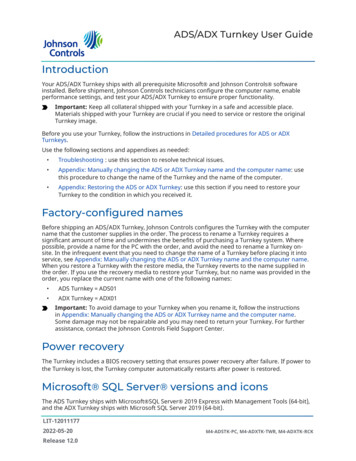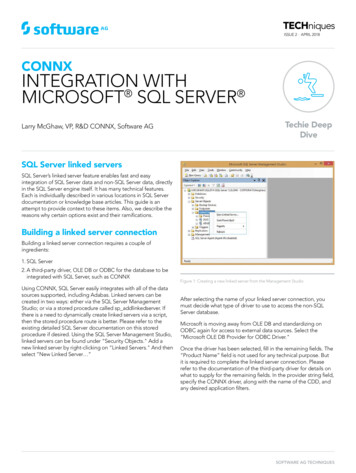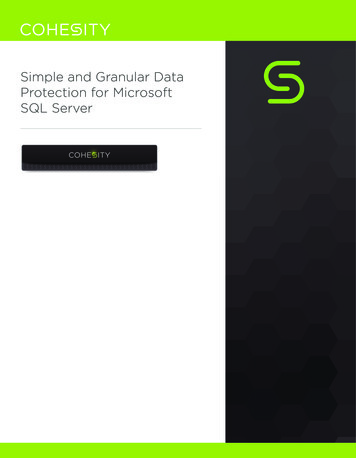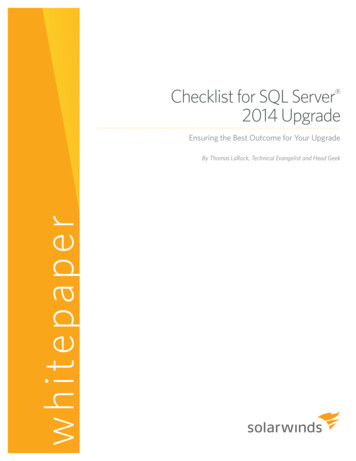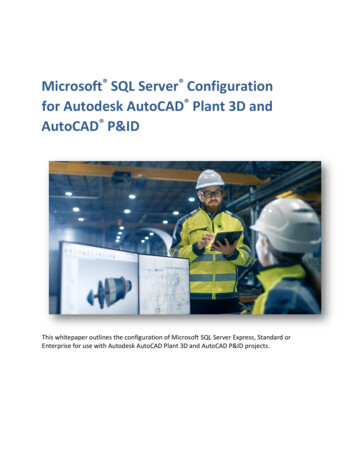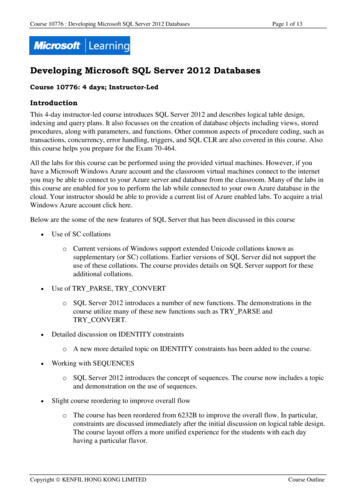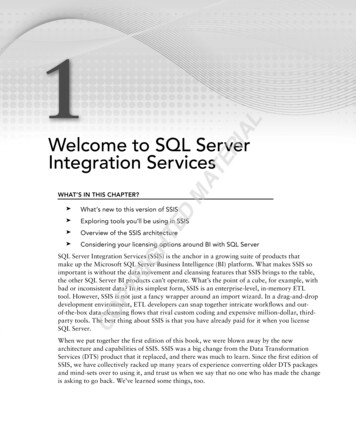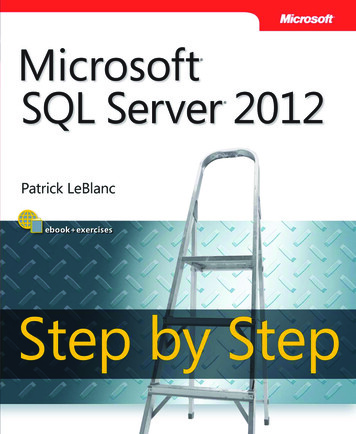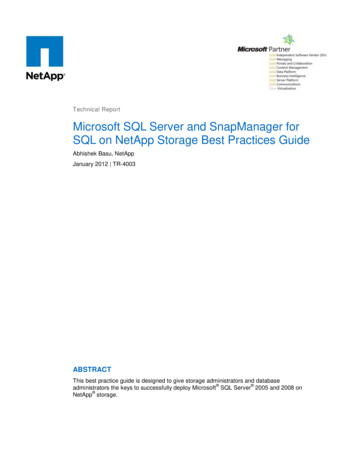
Transcription
Technical ReportMicrosoft SQL Server and SnapManager forSQL on NetApp Storage Best Practices GuideAbhishek Basu, NetAppJanuary 2012 TR-4003ABSTRACTThis best practice guide is designed to give storage administrators and database administrators the keys to successfully deploy Microsoft SQL Server 2005 and 2008 on NetApp storage.
TABLE OF CONTENTS1234567892EXECUTIVE SUMMARY . 61.1PURPOSE AND SCOPE . 61.2INTENDED AUDIENCE . 61.3CAVEATS . 7SQL SERVER ARCHITECTURE AND COMPONENTS . 72.1SQL SERVER COMPONENT MODEL. 72.2DATABASE SIZING CONSIDERATIONS . 72.3WORKLOAD SIZING GUIDELINES. 82.4APPROXIMATING DATA SIZES . 102.5BUILDING GROWTH AND CAPACITY MODELS . 10NETAPP SIMPLIFIES SQL SERVER DATA MANAGEMENT . 123.1HIGH AVAILABILITY . 123.2IMPROVED PERFORMANCE AND ASSET UTILIZATION . 153.3ACCELERATED DEVELOPMENT AND TEST WITH RAPID CLONING . 153.4FAST BACKUP AND RESTORE WITH SNAPMANAGER FOR SQL SERVER . 16DATABASE AND STORAGE LOGICAL AND PHYSICAL LAYOUT . 164.1MIGRATING FROM DRIVE LETTERS TO VOLUME MOUNT POINTS . 174.2MANAGING SPACE . 18BACKING UP AND RESTORING DATABASES WITH SNAPMANAGER FOR SQL SERVER . 205.1BENEFITS . 215.2BACKUP RECOMMENDATIONS . 215.3ARCHIVING BACKUPS . 22HOST AND STORAGE SYSTEM INSTALLATION AND CONFIGURATION BEST PRACTICES. 226.1NETAPP STORAGE SYSTEM REQUIREMENTS . 226.2INSTALLING AND CONFIGURING SNAPDRIVE 4.1 (OR HIGHER). 226.3STORAGE MIRRORING AND DISASTER RECOVERY . 24BEST PRACTICES FOR ONGOING MANAGEMENT AND MONITORING . 267.1SNAPSHOT RESERVE USING MONITORING. 267.2DISK SPACE USAGE MONITORING . 277.3FRACTIONAL SPACE USAGE MONITORING. 277.4NETAPP STORAGE SYSTEM EVENT MONITORING . 297.5TERMINAL SERVICE OR REMOTE DESKTOP . 29SNAPMANAGER FOR SQL SERVER SIMPLIFIES SQL SERVER DATABASE MANAGEMENT . 298.1SMSQL ARCHITECTURE: COMPONENTS USED BY SNAPMANAGER FOR SQL SERVER . 308.2SMSQL CONCEPTS . 30NETAPP DISASTER RECOVERY SOLUTION FOR MICROSOFT SQL SERVER . 47Microsoft SQL Server and SnapManager for SQL on NetApp Storage Best Practices Guide
9.1SQL SERVER DISASTER RECOVERY OPTIONS . 489.2NETAPP DR SOLUTION FOR MS SQL SERVER . 499.3DISASTER RECOVERY SOLUTION FOR SQL SERVER USER DATABASES . 509.4SOLUTION COMPONENTS . 509.5DISASTER RECOVERY SOLUTION: OBJECTIVE . 509.6SOLUTION ARCHITECTURE . 5010 MICROSOFT SQL SERVER RELATIONAL ENGINE: STORAGE FUNDAMENTALS FOR NETAPPSTORAGE . 5110.1SQL SERVER DATABASE STORAGE INTRODUCTION . 5210.2SQL SERVER DIRECTORY STRUCTURE . 5210.3SQL SERVER SYSTEM DATABASES . 5310.4A CLOSER LOOK AT TEMPDB SYSTEM DATABASE . 5410.5SQL SERVER DATABASES . 5610.6FILEGROUPS . 5910.7AN INTRODUCTION TO SQL SERVER TABLE AND INDEX PARTITIONING . 6410.8GENERAL BEST PRACTICE RECOMMENDATIONS. 6911 DATABASE STORAGE DESIGNS. 7411.1DESIGN EXAMPLE 1—BASIC . 7411.2DESIGN EXAMPLE 2—SEPARATE TEMPDB . 7511.3DESIGN EXAMPLE 3—SEPARATE TRANSACTION LOG. 7611.4DESIGN EXAMPLE 4—MULTIPLE FILEGROUPS . 7711.5DESIGN EXAMPLE 5—TABLE PARTITIONS . 7812 CONCLUSION . 7813 APPENDIXES . 7913.1APPENDIX A: SMSQL BEST PRACTICES RECAP . 7913.2APPENDIX B: CONSOLIDATION METHODOLOGIES . 8113.3APPENDIX C: MONITORING SNAPMANAGER EVENTS IN SCOM . 8313.4APPENDIX D: PERFMON . 8414 PHASE II: DESIGNING AND MIGRATING TO THE NEW ENVIRONMENT . 8714.1LOAD GENERATION SCRIPTS . 8814.2RECOVERING FROM DATABASE ATTACH FAILURES ON THE DR SITE . 8914.3GLOSSARY . 9015 REFERENCES . 913Microsoft SQL Server and SnapManager for SQL on NetApp Storage Best Practices Guide
LIST OF TABLESTable 1) Read/write percentages. . 9Table 2) Example 1. . 12Table 3) Recovery models in SQL Server. . 31Table 4) Software requirements. . 46Table 5) Configuration limits. . 46Table 6) Recovery options. . 48Table 7) Business problems and NetApp solutions. . 49Table 8) ACME's current SQL Server information. . 81Table 9) ACME's I/O throughputs at peak load. . 82Table 10) Recommended database placement for ACME migration. . 87LIST OF FIGURESFigure 1) SQL Server model. . 7Figure 2) SnapMirror status in SnapDrive. . 25Figure 3) SnapMirror status in FilerView. . 26Figure 4) Space alert. . 27Figure 5) SQL Server on VMDK. . 45Figure 6) Disaster recovery architecture. . 51Figure 7) SQL Server database storage stack. . 52Figure 8) SQL Server directory structure. . 53Figure 9) The MSSQL\Data subdirectory contents. . 54Figure 10) Tempdb database. . 55Figure 11) Database filegroups and files. . 60Figure 12) Database filegroups and files. . 61Figure 13) Table and index partitions in the SQL Server database storage stack. . 65Figure 14) A table and its indexes residing in a single partition. . 66Figure 15) A table and its indexes residing in five different partitions. . 66Figure 16) A table with three partitions. . 67Figure 17) High-level step flow for adding a new partition and removing the oldest partition. . 69Figure 18) Aggregates highlighted in the SQL Server database storage stack. . 70Figure 19) One aggregate with three volumes. . 71Figure 20) Screenshot of database mydb data, log, and SnapInfo file paths with no labels. . 73Figure 21) Screenshot of database mydb data, log, and SnapInfo LUNs with no labels. . 73Figure 22) Screenshot of database mydb data, log, and SnapInfo file paths with labels. . 73Figure 23) Screenshot of database mydb data, log, and SnapInfo LUNs with labels. . 74Figure 24) Basic SQL Server database design for NetApp storage system. . 75Figure 25) SQL Server database design for NetApp storage systems—tempdb on dedicated volume. . 764Microsoft SQL Server and SnapManager for SQL on NetApp Storage Best Practices Guide
Figure 26) SQL Server database design for NetApp storage systems—transaction log on dedicatedvolume. 76Figure 27) SQL Server database design for NetApp storage systems with multiple filegroups. . 77Figure 28) SQL Server database design for NetApp storage systems—table and index partitions. . 785Microsoft SQL Server and SnapManager for SQL on NetApp Storage Best Practices Guide
1 EXECUTIVE SUMMARYToday's business applications are more data centric than in the past, requiring fast and reliable access tointelligent information structures that are often provided by a high-performance relational databasesystem. Over the last decade, many organizations have selected Microsoft SQL Server to provide justsuch a back-end datastore for mission-critical business applications. The latest release, Microsoft SQLServer 2008, builds on the strong base of SQL Server 2005, delivering performance, scalability,availability, and security.SQL Server implementations have become more complex and require more reliability than before.Database service-level agreements (SLAs) require predictable performance, and outages are disruptiveand costly for database consumers. The underlying physical storage architectures supporting SQL Serverare expected to scale in order to meet the growing capacity, but frequently bottlenecks arise and backupprocesses get slower as databases grow. SQL Server databases are growing significantly larger to meetthe needs of today's organizations, while business requirements dictate shorter backup and restorewindows.Using SQL Server’s built-in streaming backup and recovery solution, restore times require the currentbackup time plus additional time to play any transaction logs. The larger the database, the harder it is tomeet organizational service-level agreements. Failure to meet the organization’s SLA can have a directand devastating effect on revenue and customer goodwill. It is clear that conventional backupmechanisms simply do not scale, and many organizations have sought new and innovative solutions tosolve increasingly stringent business requirements.1.1PURPOSE AND SCOPEThe success or failure of any software or infrastructure and software deployment hinges on making theright choices and configurations up front. The core goal of this report is to provide best practices for deploying and using SnapManager for SQL Server (SMSQL) with Microsoft SQL Server 2005 and 2008with NetApp storage systems and supporting software. Organizations looking to get the most out of theirNetApp storage investment with SQL Server will benefit from putting into practice the recommendationsincluded in this report.At a high level, the following areas are covered:New features of SMSQL and complementary NetApp technologiesBest practices for both database and storage logical and physical layout with SQL Server and NetAppstorage systems and softwareBackup and recovery (BR) and disaster recovery (DR) considerations and tactics Best practices for installation, configuration, and ongoing use of SnapDrive software and SMSQLOngoing management and monitoring best practicesNote:1.2This document highlights specific best practices in boxed sections throughout. All best practicesare also available in section 13.1 (Appendix A).INTENDED AUDIENCEThis report is intended for experienced SQL Server administrators, IT managers, and storageadministrators who have reviewed these documents:NetApp SnapDrive for Windows Installation and Administration GuideSnapManager for Microsoft SQL Server (SMSQL) Installation and Administration GuideData ONTAP System Administration GuideReaders should ideally have a solid understanding of SQL Server storage architecture and administrationas well as SQL Server backup and restore concepts. For more information about Microsoft SQL Serverarchitecture, refer to SQL Server Books Online (BOL).6Microsoft SQL Server and SnapManager for SQL on NetApp Storage Best Practices Guide
1.3CAVEATSApplications utilizing SQL Server as a back end might have specific requirements dictated by thedesign characteristics of the application and are beyond the scope of this technical report. Forapplication-specific guidelines and recommendations relating to physical and logical database layout,contact your application provider.Best practices for managing SQL Server environments focus exclusively on the latest NetApp storage operating system, the Data ONTAP architecture.2 SQL SERVER ARCHITECTURE AND COMPONENTSSQL Server is a rich relational database engine that allows flexibility for both the small department andthe large enterprise data warehouse. The flexibility of the architecture comes from the layering ofcomponents and services within the SQL Server product offering.2.1SQL SERVER COMPONENT MODELThe SQL Server component model (Figure 1) helps you understand where the moving parts areconcentrated when planning for SQL Server. The basic installation of SQL Server resides entirely on thelocal drive. The component locations can be moved around as needed.Figure 1) SQL Server model.The foundation of SQL Server is the database engine. The core engine consists of the initial 150MBneeded from the operating system to start as well as the initial portion of memory. This guide does notrecommend any particular type of drive, but describes factors you must consider when deploying SQLServer. This is important in helping customers understand that the storage designs for their SQL Serverdeployments are based on factors beyond the size of the SQL Server environment.The ability to configure the location of the specific files allows flexibility. When sizing the SQL Servercomponents, the needs of the SQL Server engine, Analysis Services, Reporting Services, and, in somecases, Integration Services must be addressed.2.2DATABASE SIZING CONSIDERATIONSThere are several considerations to keep in mind when sizing a SQL Server environment. Keep track ofthe database (system and user databases) and transaction log files, file stream data, databasecompression (in SQL Server 2008 and 2008R2), and the SnapInfo directory if you are using7Microsoft SQL Server and SnapManager for SQL on NetApp Storage Best Practices Guide
SnapManager for SQL Server. Following are the additional considerations when configuring your SQLServer environment. For details on how to configure and deploy your SQL Server environment, seesection 4 for a description of the physical layout for SQL Server.Data files (tables and indexes) are the primary files that are used by the SQL Server storage engine.Each database might have multiple files and be spread across multiple LUNs and volumes.Transaction log files operate in a sequential manner. The backup of the transaction log is stored as acopy in the SnapInfo directory.A new feature in SQL Server 2008 allows the database to be compressed, giving the databaseadministrator the ability to stretch the growth of the storage system without severely affecting thedatabase. The compression ratio varies depending on the actual data, so testing is important.Backing up tempdb is not required, because it is rebuilt when a SQL instance is rebooted. The size oftempdb is affected by features such as online database maintenance, version store, and databasequery plans.Filestream data (SQL Server 2008) allows the extension of the database for large objects such asbitmap images, text files, music files, and video and audio files. These can then be managed throughinsert, update, delete, and select statements, as well as standard SQL backup procedures.SnapInfo—calculating the SnapInfo directory if using SnapManager for SQL Server. This can beaccomplished using the following formula:SnapInfo LUN Size ((DB TRANLog Size * Daily Chg Rate * Days per TA-Log Snapshots) system databases (master, model, MSDB, and so on) SnapInfo metadata)When sizing your SQL Server environment, any additional data that can be gathered helps define theprofile of the system that you are sizing. The database sizer tool has specific data requirements. Having agood understanding of how the system is expected to perform and/or has performed in the past will helpenable the viability of a sizing solution.2.3WORKLOAD SIZING GUIDELINESSQL SERVER I/O OVERVIEWSQL Server is very sensitive to I/O latency issues due to the concurrent transactional nature of the SQLServer engine. SQL Server is built on a complicated system of row, page, extent, and table locks thatprovide transactional consistency throughout the SQL Server system. A poor I/O structure (for example,when I/O takes too long) causes resources to be held longer than necessary, resulting in blocking withinthe system. When this occurs, it frequently is not obvious that the I/O subsystem is the root cause. SQL Server customers new to NetApp might not understand the differences between RAID-DPtechnology and RAID 10. SQL Server performance has generally been centered around I/O. Thisperformance can be improved by either increasing the number of spindles or making the spindles gofaster. This is where traditional SQL environments have been slow to adopt RAID 5 or RAID 6. NetAppRAID-DP, a RAID 6 implementation, is a standard feature of Data ONTAP and prevents data loss—without excessive redundancy costs—in the event of a second drive failure.SQL Server reads. When reading data from the SQL Server, the client first goes to the buffer cache.If the data is not in the buffer cache, SQL Server goes to the I/O subsystem to retrieve the data. Thestatement does not complete until 100% of the data is read; the user connection or process remainsin an I/O wait state until completion.SQL Server writes. The user writes to the transaction log and the buffer cache. If the data to bemodified is not already in the buffer cache, then it must be read into the buffer cache from the I/Osubsystem. The buffer manager enables the transaction log to be written to first, before changes arewritten to the database. This is known as write-ahead logging. When the user makes the change andthe COMMIT is executed, a log write occurs showing that the change took place, allowing the COMMITto complete. Once the COMMIT is complete, the user process can continue on to the next stage orcommand without having to wait for the changes to be written to the disk. ROLLBACK TRANSACTION8Microsoft SQL Server and SnapManager for SQL on NetApp Storage Best Practices Guide
follows the same process as the COMMIT, but in reverse. The buffer manager moves the data fromthe cache to the disk. It keeps track of log sequence numbers (LSNs) for each log record.Transaction log. The SQL Server transaction log is a write-intensive operation that is sequential innature. The transaction log is used to provide recoverability of data in case of database or instancefailure.ONLINE TRANSACTION PROCESSINGThe Online Transaction Processing (OLTP) database system is the SQL Server environment mostconcerned about getting the greatest number of transactions through the system in the least amount oftime. Examples of different types of OLTP systems include Web order systems and manufacturingtracking systems. OLTP systems can have very large volumes of transactions per second, and for theOLTP system it is all about throughput. For these transactions to take place, SQL Server relies on anefficient I/O subsystem. According to the Microsoft SQL Server best practices article written by MikeRuthruff, an OLTP transaction profile is composed of the following pattern:OLTP processing is generally random in nature for both reads and writes issued against data files.Read activity (in most cases) is consistent and uses point queries; it does not consist of large timeconsuming queries.Write activity to the data files occurs during checkpoint operations (frequency is determined byrecovery interval settings).Log writes are sequential in nature with a varying size that depends on the nature of the workload(sector aligned up to 60KB).Log reads are sequential in nature (sector aligned up to 120KB).DECISION SUPPORT SYSTEMThe SQL Server best practices article describes the nature of the decision support system (DSS) asfollows:Reads and writes tend to be sequential in nature and are generally the result of table or index scansand bulk insert operations.I/O size varies but is generally larger than 8KB. Read-ahead is any multiple of 8KB up to 256KB(1024KB for Enterprise edition). Bulk load operations are any multiple of 8KB up to 128KB.MIXEDIn mixed environments you must take the blended approach for managing the I/O for the SQL Server.The reads or writes work out to an average, which is closer to a ratio of 40% through 60% to 65% through35%. Arranging the reads and the writes according to the proper mix of your environment defines theperformance profile for the database system. Even though mixed environments vary, a 75/25 mix forreads and writes is a good place to start. Here, you are looking for the balance between reporting andonline transactions.Table 1) Read/write percentages.9Database System TypeRead PercentageWrite PercentageDSS80%20%OLTP66%33%Mixed75%25%Microsoft SQL Server and SnapManager for SQL on NetApp Storage Best Practices Guide
2.4APPROXIMATING DATA SIZESESTIMATING I/OSEstimating the number of I/Os required for a system is crucial when sizing a database. This exercisehelps the administrator understand how to keep the database instance performing within acceptablelimits. You must estimate I/Os when you are not able to get the actual physical I/O numbers for thesystem. This is typically the case in new systems that are in the process of being constructed. Followingare the formulas for estimating I/Os.To estimate I/Os for a new database system without access to the system:1. Estimate the number of transactions for a given period size.2. Multiply the number of transactions by the 0.85 saturation rate and then divide that by the number ofseconds in a day.The seconds in a day are determined by the hours of operation for the database. If the databaseoperates in a 24-hour environment, the number is 86,400. The formula for estimating the number ofI/Os is:Total I/Os (estimated number of transactions * 0.85)/seconds in a dayFor example, if there are 40,000 transactions on a system that operates 24 hours per day, theformula is as follows:(40,000 * 0.85)/86,400 0.3935 IOPS3. After determining the I/Os required, determine what kind of system you plan to deploy. If deploying anOLTP system, determine the read and write I/Os by multiplying the number of I/Os by the percentageof reads or writes. Table 1 lists the I/O percentages for each type of system.The formula for I/Os in megabytes is ((number of transactions * 0.85)/seconds in a day) * type % I/O megabytes.For example, to determine the reads and writes for a DSS system, the formula is as follows:((40,000 * 0.85)/86,400) * 0.80) 0.3148MB reads((40,000 * 0.85)/86,400) * 0.20) 0.0787MB writesGATHERING STATIS
NetApp storage investment with SQL Server will benefit from putting into practice the recommendations included in this report. At a high level, the following areas are covered: New features of SMSQL and complementary NetApp technologies Best practices for both database and storage logical and physical layout with SQL Server and NetApp


